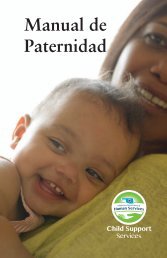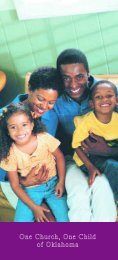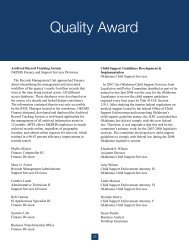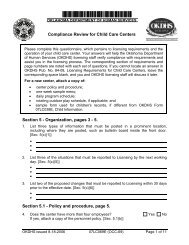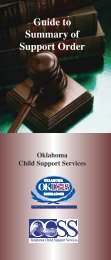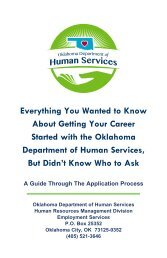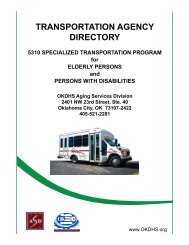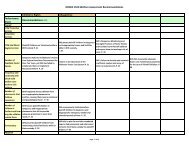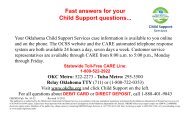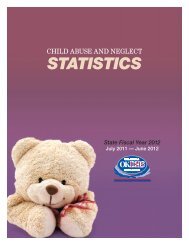The Oklahoma Pinnacle Plan - Oklahoma Department of Human ...
The Oklahoma Pinnacle Plan - Oklahoma Department of Human ...
The Oklahoma Pinnacle Plan - Oklahoma Department of Human ...
You also want an ePaper? Increase the reach of your titles
YUMPU automatically turns print PDFs into web optimized ePapers that Google loves.
<strong>The</strong> <strong>Oklahoma</strong> <strong>Pinnacle</strong> <strong>Plan</strong>:<br />
An Improvement <strong>Plan</strong> for Child Welfare Services<br />
APPENDICES<br />
March <br />
2012<br />
PINNACLE PLAN INITIATIVES<br />
SFY 2013 SFY 2014 SFY 2015 SFY 2016 SFY 2017<br />
Quarter Quarter Quarter Quarter Quarter<br />
Initiative 1 2 3 4 1 2 3 4 1 2 3 4 1 2 3 4 1 2 3 4<br />
<strong>Pinnacle</strong> Point 1 (cont.)<br />
18. By June 30, 2014, no child shall be placed in a congregate care placement unless there are<br />
specific findings documented in the child’s file, that: (a) the child’s needs cannot be met in<br />
any other type <strong>of</strong> placement; (b) the child’s needs can be met in the specific facility<br />
requested; and (c) the facility is the least restrictive placement to meet the child’s needs. No<br />
child shall remain in congregate care placement for more than 12 months without the<br />
approval <strong>of</strong> the Resource Unit program administrator.<br />
19. By June 30, 2014, shelter care is used only for short-term placement for youth 13 years <strong>of</strong> age<br />
and older, and appropriate placement is made within 30 days. Regional directors must<br />
approve stays beyond 30 days, and a report is made each month to the division director for<br />
any youth in shelter care for more than 30 days.<br />
20. By July 1, 2014, OKDHS creates a statewide matching process for children in need <strong>of</strong><br />
placements and available homes for children. This is an information technology (IT) solution<br />
that would go beyond the matching process accomplished during Year One.<br />
21. By December 31, 2014, OKDHS increases the percentage <strong>of</strong> children who receive trauma<br />
screenings at entry into out-<strong>of</strong>-home care. If the screening is positive, the child is referred for<br />
a trauma assessment, and if indicated is referred for services. <strong>The</strong> information from the<br />
assessment is provided to the child’s resource parents and therapist.<br />
22. By December 31, 2014, OKDHS increases the number <strong>of</strong> cases where a family team meeting is<br />
held for the purpose <strong>of</strong> preventing placement changes for children.<br />
23. Over a five-year period, beginning in Year One, incrementally increase reimbursement rates<br />
for resource parents to more closely align with the "Hit the Marc" standards. A monthly<br />
reimbursement rate covers the cost <strong>of</strong> caring for a child including food, clothing, shelter, daily<br />
supervision, school supplies, and a child’s personal incidentals. OKDHS realizes that a rate<br />
increase alone is not likely to improve the recruitment or retention <strong>of</strong> families; however, it<br />
will demonstrate <strong>Oklahoma</strong>'s commitment to caring for our most vulnerable children and the<br />
families who care for them.<br />
• • • • • • • •<br />
• • • • • • • •<br />
• • • • • • • • • •<br />
• • • • • • • • • •<br />
• • • • • • • • • • • • • • • • • • • •<br />
Appendix H –<strong>Pinnacle</strong> <strong>Plan</strong> Initiatives and Timeframes - 36 - | P a g e




